This article is for beginners and shows you what you need to do first in Cities Skylines. Every time I play, this checklist comes in handy. In the end, I have 3 000 $ per week so I can easily expand.
After reading this article, I would recommended reading the other two articles How to make money in Cities Skylines and How do I win Cities Skylines? to help you with your gameplay.
0. Start on the “easy” map
Before you start playing, you need to choose a good map. From my perspective, the best are flat maps (maps without mountains or rugged terrain) because you have enough place to build everything you need. The second thing I recommend is a map with rivers so you can deal with sewage (it just flows…)
There is the list with flat maps which are available to all players:
- Grand River
- Green Plains
- Riverrun
- Two Rivers
On these maps you don’t need to make compromises – you can build as much as you want. After a few games on a simple map, you can choose challenging maps that are more complex because you will know what will happen and when.
🪄 If you are a beginner, choose easier maps – this will help you. 🪄
1. Plan how your city will grow
You only have 60 000 ₡ to start with and you have to spend it the right way. Before you start building roads, infrastructure and zones, you need to plan how your city will grow.
I think the best concept is to separate industrial zones from the rest of the city. Thanks to that you will have two parts – one would be industrial and the second one would be residential and commercial. Why do I like to separate them? This is because the industry at the beginning of the game generates a lot of pollution and my citizens don’t want to live near pollution. It’s because they will be sick and I will have big health care expenses.
So when I start out, my city usually looks like this…
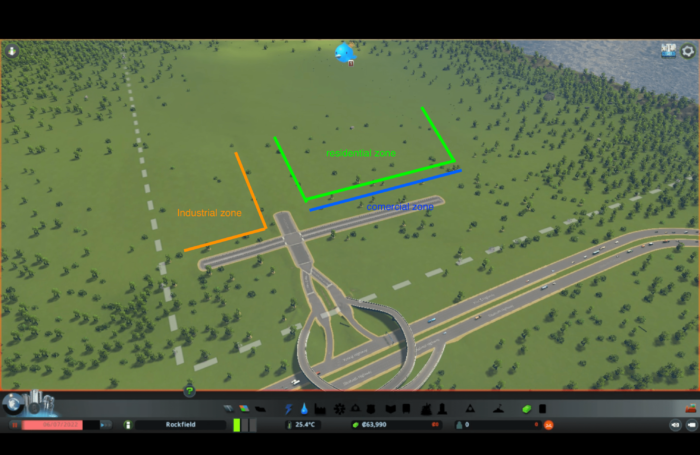
… this is my “test city” with which I will show certain demonstrations. As you can see, I separated industry from the rest of the city. The second thing I will do is to centralize commercial zones to the main road.
✅ City planning and separate zones are a good place to start – do it! ✅
2. Build electricity and power
After planning the core of your city, major services need to be prepared. In Cities Skylines there are two – 🚰 water and 💡 electricity. These you must provide for your citizens or they will leave the city. If you have a map with a river, its service will be easy.
You need to build a water pumping station to provide clean water from the river to your citizens and wastewater discharge. When you build these two, you have to be sure you are building downstream. Therefore, wastewater is not pumped to citizens.
On my map, I’m building water buildings like this…
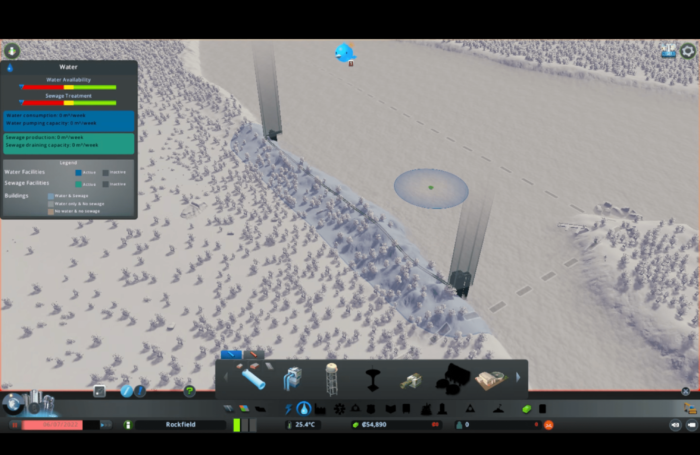
… first is the pump and behind it is the wastewater discharge. These two buildings need to be connected by pipeline and then the pipeline needs to be connected to the city.
The second thing you need to build is power plants. To begin with, I need to build a wind turbine that costs only 6 000 ₡ and will give me 8 MW (if you place this turbine in a good location). In the picture below you can see that I’m building this turbine close to the water pump and connecting the sewer with the power lines…

… after connecting this critical infrastructure I’m connecting the previously mentioned wind turbine with the city. You can build a tower but you need sewage in every case. For this reason, I’m building this critical infrastructure all at once. If you have the DLC, you can build a water purifier, but it’s not in the vanilla game.
✅ Critical infrastructure goes first, because you need money ✅
>> More about power in Cities Skylines <<
3. Build roads
When you have plans and critical infrastructure, you can build roads. From the highway, I’m building a 6-lane road, which I call “highway” (green in the picture), from this road I’m building 4-lane roads which I call “the main roads” (pink in the picture), and from these 4-lane roads I’m building 2-lane roads. These I call “the last mile” (blue in the picture).
You can see one of my default templates in the picture below:
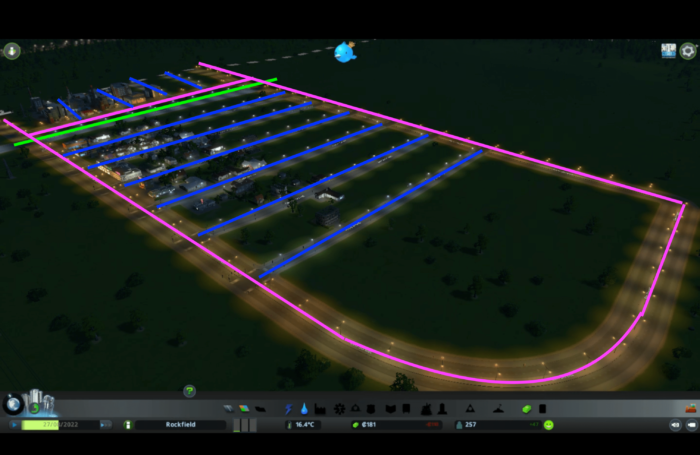
This template is enough for the city’s future growth and provides good traffic flow. Each specific road has its main goals:
- “highway” goal is to connect main roads faster
- “the main road” goal is to connect the highway and the last mile
- “the last mile” goal is to connect residential/industrial zones with other parts of the city
This screenshot is when my city has a population of 260 citizens (now I’m thinking you don’t have enough people and money). I put it there for you to get an idea of what I mean.
✅ Build roads systematically from the start ✅
4. Create first zones
As I have shown in the chapter above, it is good to separate the city into two parts and near the “main roads” to build commercial zones. First, I would recommend building the “main roads” and in the first 4 squares to create commercial zones. After that, I would recommend build the “last mile” where should be placed residential zones.
When starting, you only need these two zones. In the picture below, you can see my city in the first few minutes when I have some basic roads and basic zones. As you can see, the first zones I’m creating are residential. After that, I would recommend building some commercial zones and then industrial buildings.

In the beginning, you can only build these “basic” roads. However, late in the game (when your city grows) you will have to build roads with trees. These roads are maybe more expensive and have larger unmaintained areas, but will reduce noise pollution.
✅ Commercial near main roads, residential near the last mile ✅
5. Build build build
Now that you have the basics, we are at the part where you need to build, build, build. In Cities Skylines, there are three bars that show how much demand your citizens have for certain types of zones. In this screenshot, you can see where these “magic bars” are located:
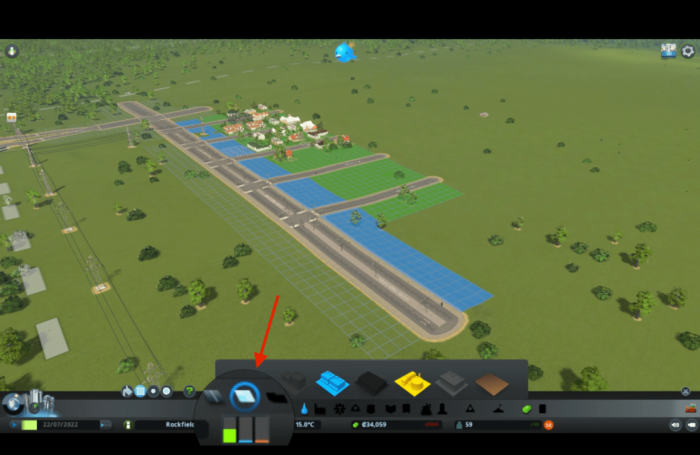
The game will show you what you need to build and don’t worry, you will never see zero in all those bars. So every time there is something to build, build it. You need to increase the number of citizens to open milestones.
In Cities Skylines, there are 13 milestones and each of them unlocks more buildings and services. My tip is to expand your city as much as possible. Try to be creative.
✅ Watch the demand in the zones and get creative! ✅
6. Set taxes to 13%
When your city reaches 420 inhabitants, you get the opportunity to set taxes. You want to set them to 13%. It is simply the best setting…
… you will get a lot of money and people won’t be afraid of you. If you set more than 13%, you will have problems with your citizens and their happiness will decrease.
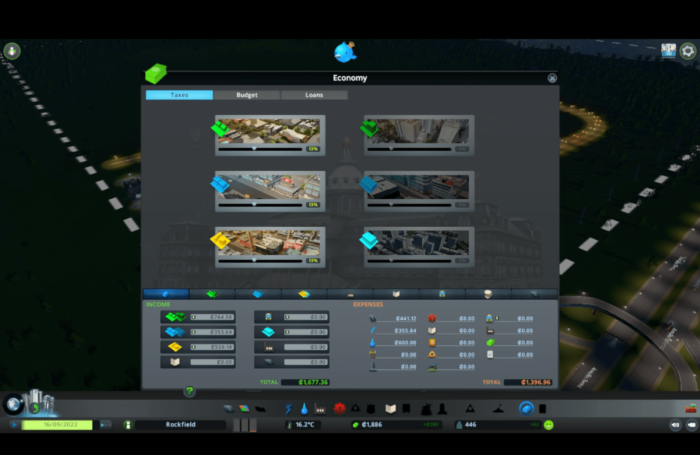
This isn’t a long-term matter. At the end of this tutorial we will reduce the taxes to 10%. So that you will have a free space where you can go you are short of money. That way you will be well taken care of and always have an insurance policy.
✅ Taxes on 13% are good, but not as a long-term solution ✅
>> More about how to make money in Cities Skylines <<
7. Build landfill site
After setting taxes up and playing for some time, first problems with garbage may occur. You can deal with it when your city makes the 420 milestone and build a building that can handle it, or you can wait.
The building must be build when a certain icon appears above your residential buildings (picture below). This icon means that the building produced a lot of garbage. If the icon is red, the garbage situation is critical…
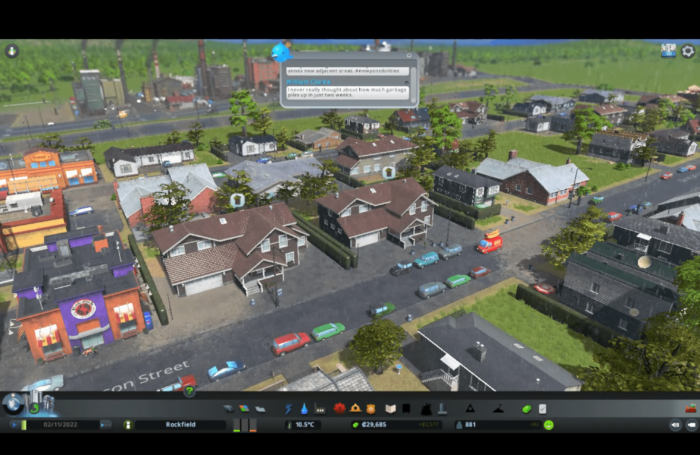
… for this reason you must build a landfill site. The best place to build it is in the industrial zone, mainly because landfill sites produce pollution. You also need good transport accessibility because you will be working with 15 garbage trucks.
✅ If you have problems with garbage, deal with them ✅
8. Elementary school, hospital, and fire station
When you have garbage service, the next step is providing education to your citizens. In Cities Skylines, there are four classes of education – “uneducated”, “educated”, “well educated” and “high educated”. Each building needs people from each class.
However, be aware that when you build services, you need to think about where you build them. You want to build services on the main road (orange in the picture) because they can support multiple buildings. In the picture below, you can see where are the elementary school and hospital placed…
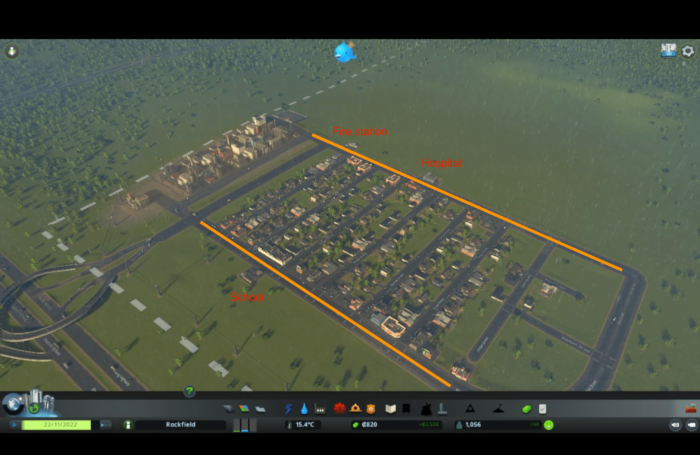
… as you can see, I built them on the main road in the middle of the residential distinct. As you can also see, the fire station was built much closer to the industrial distinct. Is it because there is a bigger chance of fire than injury.
✅ Centralize services on main roads ✅
9. What do your citizens need?
That’s a good question. We can say that now you have everything you need to prosper, however, you must be attentive to the needs of your citizens. You need to figure out what to do when some icons appear as in step 8. The second thing that you need to look for is this…
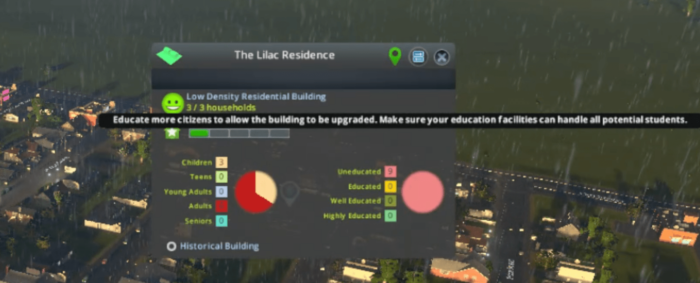
… when I point to the first “green” block of the scale, you can see that my citizens need to be more educated to create bigger and wealthier buildings. If you do not provide enough education, there is a risk that the residents will leave you and the houses will be abandoned.
✅ Look after your citizens needs ✅
10. Double your zones
The next challenge would be to double your zones. You simply want to expand your city. As you see I built a fire station and hospital on the second “main road”. From this road, I can now expand.
In the image below, you can see how I doubled my town in size…
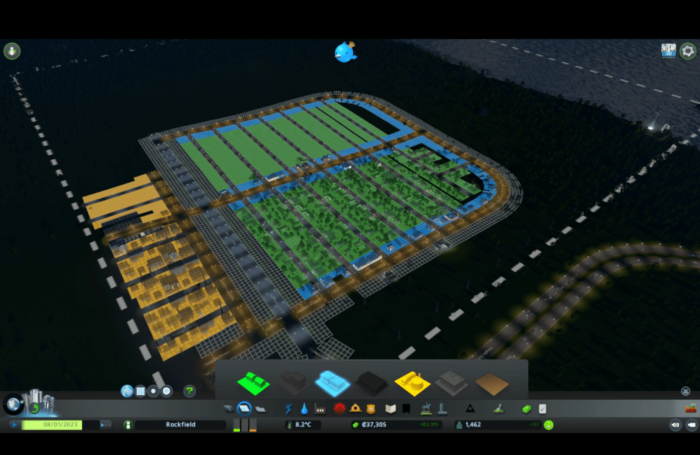
… near main streets are commercial zones and between them are residential zone. After this, my town will grow. All I need to do now is to watch my citizens for a while.
✅ If you have time and resources, expand! ✅
11. Police station
Bigger problems with population => bigger problems with crime. After you double your zones, it is time to build a police station. I would recommend building it between the hospital and fire station because you need police in the middle of the city.
12. Build parks
After all of this, the city is still missing something – parks and unique buildings. Their main purpose is to entertain and satisfy your citizens. However, keep in mind that parks aren’t just for citizens, they are also good for your city treasury. This is because they increase the value of houses and if houses are more valuable, you collect more in taxes.
✅ Parks are the best ace up your sleeve in terms of making money. ✅
13. Problems with electricity
After parks, you may have problems with electricity. To deal with them, you should build your first coal power plants. These cost more than a wind turbine but from a long-term perspective they are much cheaper. If you have the option, it’s better to build a solar power plant because it does not pollute the environment.
Or if your city grows to 10,000 inhabitants, you can build a garbage incinerator that generates electricity. However, in my experience, it does not provide enough electricity to power the entire city.
✅ Use turbines to start, then coal and finally solar power! ✅
14. Reduce taxes to 10%
Now you have everything from the basics done. What to do next is to cut your taxes to 10% as I mentioned above. There will come a time when you will have problems with the city budget and will be looking for more money. That’s when your time will come and you will be able to assess the taxes back at 13%.
And what to do next?
Read our article on the goals in Cities Skylines and play!